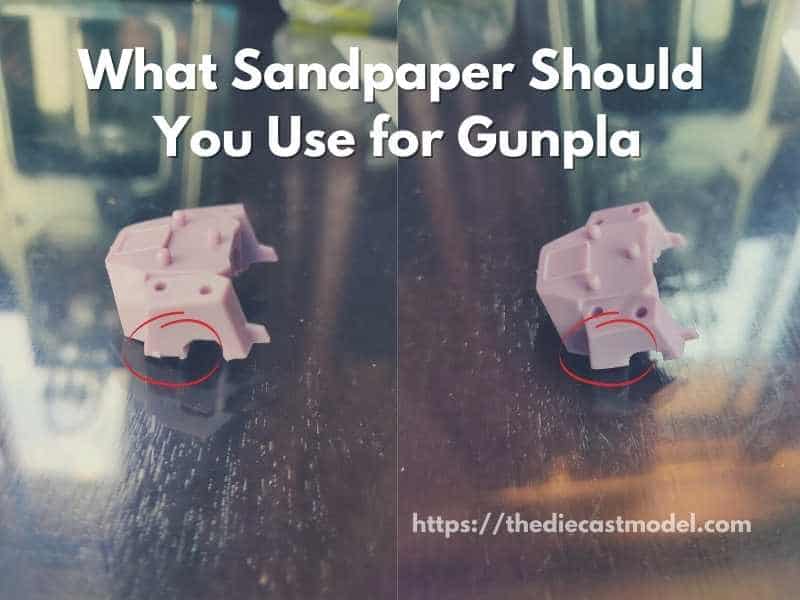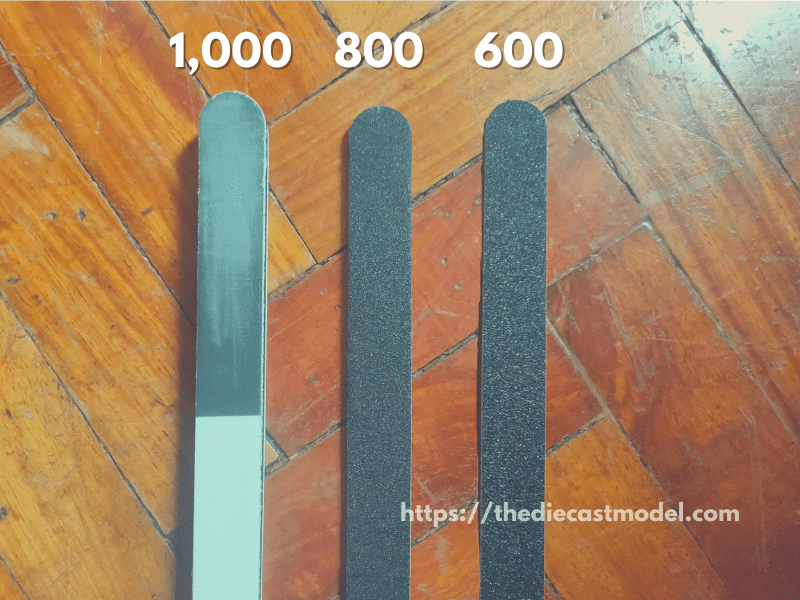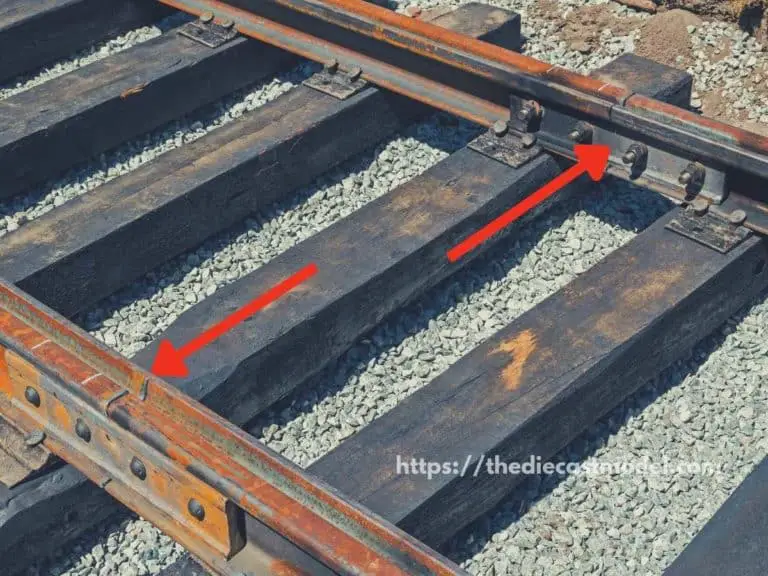What Sandpaper Should You Use for Gunpla | A Gunpla Sandpaper Guide
Sanding is an exciting experience for modelers as they try to smoothen the stress and nub marks. Furthermore, they are also used for smoothening top coats before rubbing and buffing. When I was a beginner in Gunpla modeling, I had a lot of fun sanding my models to smoothen their surfaces. However, I also experienced using the incorrect grit to smoothen my model and broke it instead. With all these experiences, I decided to write this post and help people use sandpaper for their models. So, what sandpaper should you use for Gunpla?
As a general rule, you should use grit 600, 800, and 1000 sandpaper for Gunpla modeling. Everything else is optional, and you can remove nub marks without using other grits. However, using other grits can accelerate the building time, such as using 250-400 grit, or make the surface smoother by using 1200-2000 grit.
This post will give a comprehensive guide on all the grits used in Gunpla modeling. Which are the most important ones? Which are optional? When are they useful? We will discuss all of these in this post.

| Sandpaper Grits | Particle Size | Use In Gunpla Modeling | Sandpaper Classification |
| Grit 400 | 35 | Removing Excess Plastics (Fast) | Extra fine |
| Grit 600 | 25.8 | Removing Excess Plastics (Slow) | Extra fine |
| Grit 800 | 21.8 | Smoothening Surface (Initial) | Superfine |
| Grit 1000 | 18.3 | Smoothening Surface (Final) | Superfine |
| Grit 1500 | 12.6 | Used to Further Smoothen the Surface | Ultra-fine |
| Grit 2000 | 10.3 | Produces the Smoothest Surface | Ultra-fine |
What grit sandpaper is best for Gunpla?
The best grit sandpaper for Gunpla models depends on your purpose for using them. For example, if you need to remove large amounts of plastic fast, then using 400 grit is the best since their particles are very coarse. However, grit 400 isn’t ideal for smoothening surfaces. Thus, for the best finishes, use grit 2000.
However, you won’t enjoy Gunpla modeling with these two grits since using grit 2000 right after 400 wastes a lot of time and energy for the modeler.
Thus, we need to know which grits to use and in which order.
Learning the basics is essential before trying grits 400 and 2000 since these grits are used for particular purposes.
So, if we want to start with the basics, we have to learn the three grit sandpapers for Gunpla modeling: grit 600, 800, and 1000.

1. Grit 600
Grit 600 Sandpapers are one of the most commonly used grits for Gunpla modeling. They are usually the grittiest sandpaper a modeler has since they can remove plastics fast.
While they aren’t as fast as a grit 400 sandpaper, they get the job done without worrying about over-sanding.
The grit 600 is best used for removing excess plastics. Excess plastics are usually common, especially if we don’t want any stress and nub marks on our models.
Don’t worry about using these grits since I have a video tutorial of how I used these grits later.
But you need to remember that this should be the first grit you use when sanding a model, especially if you are removing excess plastics.
This grit does the job at a reasonable pace compared to lower grits that can over-sand your model.
The grit 600 is on the right side in the picture above.
2. Grit 800
Grit 800 serves as the middle ground between grit 600 and 800. the purpose of grit 800 is to prepare the model before grit 1000.
Grit 800 is the 2nd sandpaper you should use after using grit 600. This grit prepares the model for grit 1000.
But why? Why should we use Grit 800 if we can use Grit 1000 right after 600?
The truth is, we can use grit 1000 right after grit 600.
However, it will take time because grit 600 is too coarse. Thus, we must use grit 1000 for a very long time before smoothening the surface.
For this reason, modelers use grit 800 first to make it faster.
Sanding is a fun but tedious process since you have to rub the paper on the model repeatedly.
Thus, using grit 800 makes it easier.
This is also the reason why even if the grit 400 is the fastest and grit 2000 gives the smoothest finish, we can’t use only both of these grits,
If you jump from grit 400 to grit 2000, you may sand your model for an hour before being satisfied with the result.
Instead, we make it easier by using something in between.
This is why most Gunpla modelers have at least three grit sandpapers in their arsenal, as the middle one is used for preparation.
3. Grit 1000
Grit 1000 is often the last grit a Gunpla modeler uses to smoothen its model’s surface. This grit makes the surface smooth and ready for building.
Most people ask if grit 1000 does the best job smoothening our Gunpla surfaces. The answer is they aren’t the best, but they do a good job of smoothening surfaces.
Sanding takes a lot of time, especially in Gunpla modeling. Thus, we should consider the quality and time it takes to finish the model.
When it comes to smoothening the surface, grit 1000 is average. They aren’t better than, let’s say, 1,500 grit.
However, their finished product is already considered good.
Furthermore, they will save a lot of time compared to going for higher grits.
That’s why many modelers stop at this grit since they already find grit 1000 great.
However, this is also why you hear people on the internet telling you that they stop at grit 2000 or 2500.
These are the modelers that aren’t satisfied with the results of grit 1000.
These grits will produce a smoother surface but will sacrifice lots of time.
These three grits are enough when starting Gunpla modeling. You can indeed build something great with these three.
If you are interested in how to use these sandpapers, you may check my video below.
One question that might bother you is if you can use sandpapers sold on your local hardware.
You can use the sandpapers from your local hardware to build Gunpla models. However, it will be harder to control rubbing them since they don’t have a handle.
However, here is a secret tip.
Use a popsicle stick as a handle. Pur the sandpaper on the popsicle stick and use it as a handle.
That way, you can easily control the sanding.
However, this is a temporary solution. If you plan to build models often, getting a model file will be better.
4. Grit 250-400
Grit 250 and 400 sandpapers are best used when removing large amounts of plastics on Gunpla models.
You can hear people saying that they start with grit 250 or 400. They can do that since these grits tend to be very fast.
Compared to the grit 600, these grits tend to sand models fast.
However, beginners should avoid them as they can over-sand your model.
A basic rule of sanding is it is better to sand less than to over-sand as over-sanding is irreversible.
Thus, while their speed in sanding can look attractive, beginners should stay away from these grits for now.
5. Grit 1,200 – 2,000
Grit 1200 to 2000 are often used to smoothen the model’s surface further. They produce better results than grit 1000 at the cost of time. Thus, modelers who are sensitive to quality love using these grits.
Finally, you might see others saying they use grits 1,500 to 2,000 as their final finish. Some might even go as high as 2,500.
Well, these grits produce the smoothest surface. If you find grit 1000 to be great, then prepare to be amazed when you use grit 2000.
However, using these grits takes a lot of time since they are ultra-fine sandpapers.
Feel free to use these grits if you want better results. But remember to use grit 1,000 first.
For example, you want to end with grit 1,200. Then start with 600, 800, 1000, and then 1200.
With all of these, I suggest returning to the video and learning how to use these sandpapers. Good luck!
What’s next? Priming is an essential step when painting Gunpla models. The problem is most people tend to skip this step when painting. Thus, If you plan to paint Gundam models or are currently painting one, it will benefit if you find out the benefits of priming your models. I made a post about that topic which you can find here: Do you need to prime Gunpla models?







